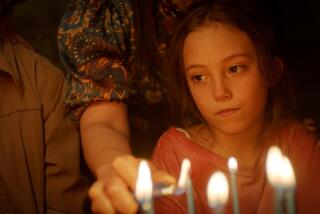Research Sheds New Light on Cinema Pioneer
- Share via
ALICE GUY BLACHE
Lost Visionary of the Cinema
By Alison McMahan
Continuum
362 Pages, $35
Alice Guy Blache (1873-1968) was the young secretary-office manager to French film pioneer Leon Gaumont who persuaded her boss to let her try writing and directing some shorts that were to become among the first fiction films ever made.
She and her husband, Herbert Blache, immigrated to America, eventually setting up their own production company that had all-too-brief success. By 1920, Guy Blache had directed her last feature, and she would die in virtual obscurity in New Jersey.
Even so, it is supremely significant for film historian Alison McMahan in her book, “Alice Guy Blache: Lost Visionary of the Cinema,” that Guy Blache’s 24 years behind the camera constitutes the longest career among the cinema pioneers, embodying the full flowering of the feature-length screen narrative.
In telling Guy Blache’s story, McMahan, who teaches at Vassar, has done a monumental job of excavation to locate her subject’s place in the history of the cinema, a place that proves to be more important than previously realized. McMahan lays out the evolution of the cinema, and its development that went hand-in-hand with studies in motion and even aerodynamics. She sees the movies emerging as part of a great, interconnected “drive to mechanize” that characterized the 19th century’s age of invention. The birth of the movies was like that of the automobile, an international parallel, competitive phenomenon.
What is important here is not so much whether Guy Blache made the first fictional film, something she never claimed. McMahan shows that Louis Lumiere takes that honor, with Guy Blache vying with Georges Melies for a none-too-shabby second place. Gaumont, concerned above all with selling movie equipment, was not interested in movie-making at a time--1896--when the movies were essentially brief newsreels or film records of music hall entertainers or any other “actuality” that caught a cameraman’s eye.
But Guy Blache had another idea. She asked Gaumont’s permission to write a little sketch and would ask some friends to act under her direction. (It was a brief tale about a woman buying a baby from a fairy.) She would shoot it in a patio at the Gaumont plant. Gaumont said yes--provided she not skimp on her office duties.
Guy Blache would put in extremely long hours before she became Gaumont’s very successful sole filmmaker, eventually hiring others and laying the foundation of the studio system long before Thomas Ince and his Culver City studio.
In culling the 111 extant films of Guy Blache--stored in many places, some in desperate need of preservation, among the more than 1,000 she made--McMahan has traced Guy Blache’s steady growth as an innovative screen storyteller who discovered the power of the close-up long before D.W. Griffith did.
Guy Blache also displayed a feminist sensibility without being preachy. She saw women and men as equals. She treated her husband, who was involved in the business end of the company and studio, as an equal even though he was not up to her level.
He may have run off to Hollywood with one of his actresses after the loss of their Fort Lee, N.J., plant, but McMahan evenhandedly refutes that it was Blache who ruined the business. McMahan shows that as the teens wore on and the motion picture industry expanded convulsively, Guy Blache could not get distribution for the films she produced. She began making short sound films in 1902, launched some major careers (including that of France’s great serial king, Louis Feuillade) and, the only woman filmmaker to this day who owned her own studio, became a director for hire.
In her memoirs, Guy Blache does not say why in the early ‘20s she forsook Hollywood without apparently trying to find work here, to return to France with her two young children. McMahan suspects that having lost her studio and her husband, she craved the solace of family in France. (A lack of funds to invest prevented her from reactivating her career at Nice’s fabled Victorine Studios.) She supported herself mainly by writing novelizations of films and returned to the U.S. at the outbreak of World War II.
McMahan provides appendices that reveal the collaborative detective work essential to accurate film history. She also provides a filmography, a daunting achievement when so much of her subject’s work has been lost and much of it was uncredited on the screen. McMahan then caps her own major feat of enlightened--and enlightening--scholarship with a complete list of where all of Guy Blache’s known films reside, leaving us eager to see them for ourselves.
More to Read
Only good movies
Get the Indie Focus newsletter, Mark Olsen's weekly guide to the world of cinema.
You may occasionally receive promotional content from the Los Angeles Times.










